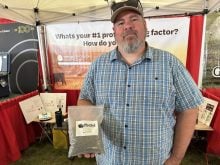Nitrogen fertilizer is much in the news this winter with the feds talking about seriously reducing its use to save the planet.
This piece appears here at this time because I have just read Kevin Hursh’s March 1, 2022, column in The Western Producer with headline, “Have your say on reducing fertilizer emissions.” He makes common sense arguments about how we can be led down a bad path. He is urging the farm community to respond to the discussion paper the feds have out. To access that discussion paper just Google, “discussion paper on nitrogen fertilizer emissions.”
The very first column I penned in Grainews in October 1976 was, “Nitrogen — when, what kind and how much to apply.”
Read Also

Claas brings 1000 Series SP forage harvesters to Canada
In mid-August, Claas unveiled its new line of Jaguar forage harvesters at an event in Visalia, California, deep in the heart of that state’s dairy region.
At that early date we had three of the 4Rs — placement, the fourth R, was yet to come. There is an interesting story to the fourth R. When serious nitrogen fertilizer use became common practice on the Prairies in the 1970s, anhydrous ammonia (82-0-0) and urea (46-0-0) were competing sources. Urea was broadcast, with or without incorporation by tillage. Anhydrous ammonia is a gas, so it had to be deep banded at three to four inches into the soil. Early work suggested that crop yield with anhydrous was often higher than urea at the same rate of nitrogen.
John Harapiak with, then, Westco Fertilizers, did a three-province study comparing urea broadcast with urea deep banded. His conclusion was the difference in yield between broadcast and banding was enough to pay for the fertilizer. Deep banding of urea became common.
The 4Rs are the way to go without doubt. However, there is not one recipe that fits all farming situations. For my little farm at Dundurn, the right source was anhydrous ammonia, the right time was fall, the right placement was three to four inches deep, and the right rate was somewhere between 50 and 100 pounds of nitrogen per acre.
A nitrification inhibitor for anhydrous ammonia has been commercially available for many decades. What we must realize is anhydrous ammonia is its own nitrification inhibitor. In the “hot” zone, where anhydrous is placed, microbial activity is delayed by the high ammonia concentration and high pH.
Nitrogen and the environment
Excess nitrate nitrogen in the soil can be washed down below the root zone (leaching) or gas off to the atmosphere as N2O (nitrous oxide) — a greenhouse gas.
Leaching
Leaching only applies to wet climates and over-irrigation. A real problem with excess nitrate leaving the field is in the corn states that drain to the Mississippi River and hence to the Gulf of Mexico, where it contributes to a “dead” zone. There is a large body of literature documenting that and much work being done to reduce the amount that gets into the waterways, particularly from tile drains.
Nitrate in wells and blue baby syndrome
Nitrate that gets into wells used for human consumption is bad news, especially for babies. It can lead to death. That problem was discovered in 1945 in Iowa. In 1948, a Saskatchewan survey of 2,000 farm wells found 18 per cent of those wells were contaminated with nitrate. That was long before any significant nitrogen fertilizer use. The nitrate source was from mom-and-pop-type livestock operations in the farmyard. There were even situations where wells were contaminated just from soil organic matter breakdown.
Readers who would like to learn more about nitrate-contaminated wells can access, “Fertilizers and Groundwater Nitrate,” by J.L. Henry and W.A. Meneley by simply putting the title and authors into Google and the complete report will pop up. It is on the Saskatchewan Water Security Agency website.
Gassing off: Denitrification
Broadcast or shallow banded urea is subject to volatile loss including N2O gas, which, as mentioned above, is a greenhouse gas. There are various products that can be added to granular urea to reduce that loss. The loss of N2O gas happens in spikes with rain or irrigation and some additives do reduce that loss. However, that loss is measured in grams of nitrogen per hectare. In many cases, there is little or no extra yield from the additives.
There are many field studies that deal with the topic, but one that is current, very comprehensive, conducted over multiple years and includes rainfed and irrigation is, “Environmental and Agronomic Benefits of Enhanced Efficiency Nitrogen Fertilizers,” by Rich Farrell, department of soil science, University of Saskatchewan. It was presented at the 2020 Soils and Crops Conference in Saskatoon and can be accessed at the University of Saskatchewan website. It showed significant reductions in N2O loss for some products, but losses were reported in grams per hectare and there was no yield benefit. The data is presented in a very readable fashion and the conclusions are clear cut.
IPCC Sixth Assessment
How many have read the International Panel on Climate Change (IPCC) Sixth Assessment Report released last August? The downloaded PDF runs to 250 MB and is a formidable document to say the least.
The IPCC Sixth Assessment Report’s Summary for Policymakers is 41 pages, so I struggled through most of that. What it actually says about drought in our neck of the woods is much different than what we are led to believe. We are included in a hexagonal area described as NWN, or North-Western North America.
That hexagon appears to include the Northern Great Plains, the mountain regions, the West Coast, Alaska, Yukon and Northwest Territories. There is no actual geographic reference so one has to guess at the actual extent. Anyway, what it says about that area on page 12 of the summary is, “Low agreement in the type of change with low confidence in human contribution to the observed change.” That is not what we hear in most of the media reports that say we will cook out and dry out.
Now to N2O gas
What the Summary for Policymakers says about greenhouse gases on page nine is, “Since 1750, increases in CO2 (47%) and CH4 (156%) concentrations far exceed, and increases in N2O (23%) are similar to, the natural multi-millennial changes between glacial and interglacial periods over at least the past 800,000 years (very high confidence).”
It says the increases in N2O are similar to natural, long-term changes. That is not what we are led to believe. If that is true, why are we tying ourselves in knots to reduce the grams per hectare loss?
Access to the IPCC Sixth Assessment Report is easy — just put those words into Google and it will pop up. Please do have a look at the Summary for Policymakers.
And, please do respond to the federal, “discussion paper on nitrogen fertilizer emissions,” and get your opinion recorded.
With that, I rest my case.
















